(Quick update: Duolingo just added a huuuuge amount of grammatical explanation to every lesson, at least in French. This was one of my biggest complaints about the service, and it has been immensely improved! I’m still going through it, so I’ll update this article with comments about it as I progress, but it already looks like a great update.)
Oh, language barriers. Instigators of so much awkwardness and discomfort.
We’ve probably all studied a foreign language back in school, forgot practically everything, and kicked ourselves for never moving beyond the nuisance of monolingualism. Plenty of adults think of taking language classes, but it’s not the sort of hobby that can be approached casually; the time commitment is daunting, and conversational abilities rapidly deteriorate without attending those classes forever.
So I was rather looking forward to using Duolingo, which is a totally-free language learning program that claims to be just as effective as competing (and more expensive) programs like Rosetta Stone, and even comparable to classroom lessons with teachers fluent in that language. They’ve currently got Spanish, French, German, Italian, Portuguese, Dutch, Irish, Danish, and Swedish, and are in the process of adding several more.
It’s actually more clever than that, though; rather than simply providing language lessons, it’s simultaneously a translation tool. As you build up your vocabulary, the program presents you with (optional) real-world digital texts, and users submit their translations, and vote for the best answer. The site is actually solving two problems at once: Translating the web, and teaching languages. Major publications pay Duolingo for translation services, thereby providing the funding for Duolingo to offer free language lessons to millions. It’s just brilliant.
And I’m happy to say I’ve finally finished all the French lessons on Duolingo, from start to finish, with no previous French experience whatsoever, and was awarded this digital golden owl trophy as a reward:

I’ve been recommending Duolingo to everyone who mentions language learning ever since I first heard of it, which usually goes something like “Man, I’d love to learn another language. But I wouldn’t know where to begin.” And I tell them to start using Duolingo. About a week later, they write back to say they’re loving it.
So I’m happy to say that I can finally provide a more thorough review than “use it.” After progressing all the way through Duolingo’s French lessons, I went straight to a French language conversational get-together organized through Meetup.com to see how it all worked out, and a very clear picture has emerged of what can be expected from it.
I highly recommend it…but with a few pointers for the more troublesome areas.
A little about me and my language background
I’ve studied a few languages before; I took Spanish for 8 years, including a year studying abroad in Spain, and spent some time backpacking through Central and South America. I’m at the point of near-fluency, with exceptions for slang terms and heavy accents. I also studied 1 year of Russian, and got some practice during trips through Russia and Eastern Europe. I’ve also taught English in Taiwan in a classroom setting, and Spanish as a private tutor.
So “language expert” isn’t quite accurate, but I’ve studied and taught multiple languages over the course of many years, and this was my basis of comparison for evaluating Duolingo as a language-learning tool. So I’m comparing it to classroom learning, rather than other sites or apps (though I’ll try to add my thoughts on alternatives as I go through them).
How long did it take?
Well, I did it off and on for about 2 years, but I ran through the last 1/3 of the lessons in about 2 weeks. I was trying to make it all the way to the end for the sake of this review, so of course my knowledge of the latter half is rather shaky when compared to earlier lessons.
I would say it’s reasonable to expect that with consistent effort of maybe an hour per day, you could finish within several months, depending on how quickly you pick it up. Having prior knowledge of a similar language is extremely helpful when it comes to vocabulary, for example; knowing Spanish and English ahead of time made the jump to French much easier.
(It’ll also be even faster with a language like Spanish, where they actually pronounce the damn letters correctly, instead of French with that nonsensical silent s everywhere…)
So, can I speak French?
Kinda! I sped through the latter half of the lessons, and that’s what contained the bulk of the more challenging grammar rules, but I’m quite satisfied with the range of material it covers. I was able to get by, though I definitely need more practice on the later sections.
Duolingo runs through what appears to be the equivalent of a year or two of college language courses; it teaches you what appears to be all the grammar, and lots of vocabulary. By the time I was finished, the lessons had included 1854 words, and I’ve heard that 2,000 words is the sweet spot for conversational fluency. Not enough for reading a legal document or comprehending flowery poetry, but enough to be conversational and have a good time.
The lessons are organized into 71 groups, like this:
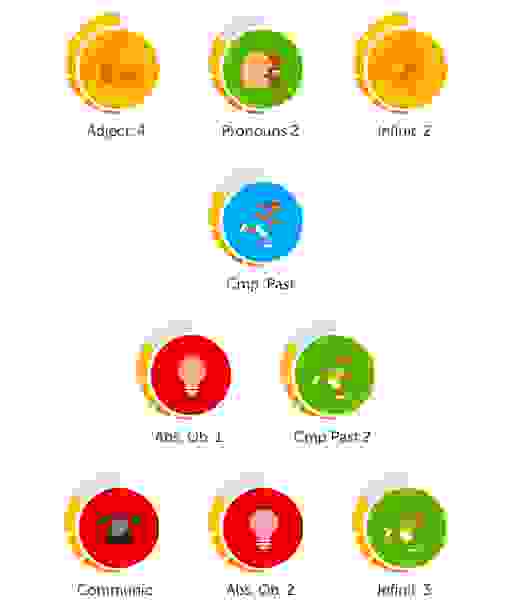
They turn gold after you complete them, and gradually deteriorate as time goes on, prompting you to repeat them to get more practice. And yes, I did in fact finish with 100% gold on everything. So HA!
Each of those sections is further subdivided into 2 to 10 lessons, like this:
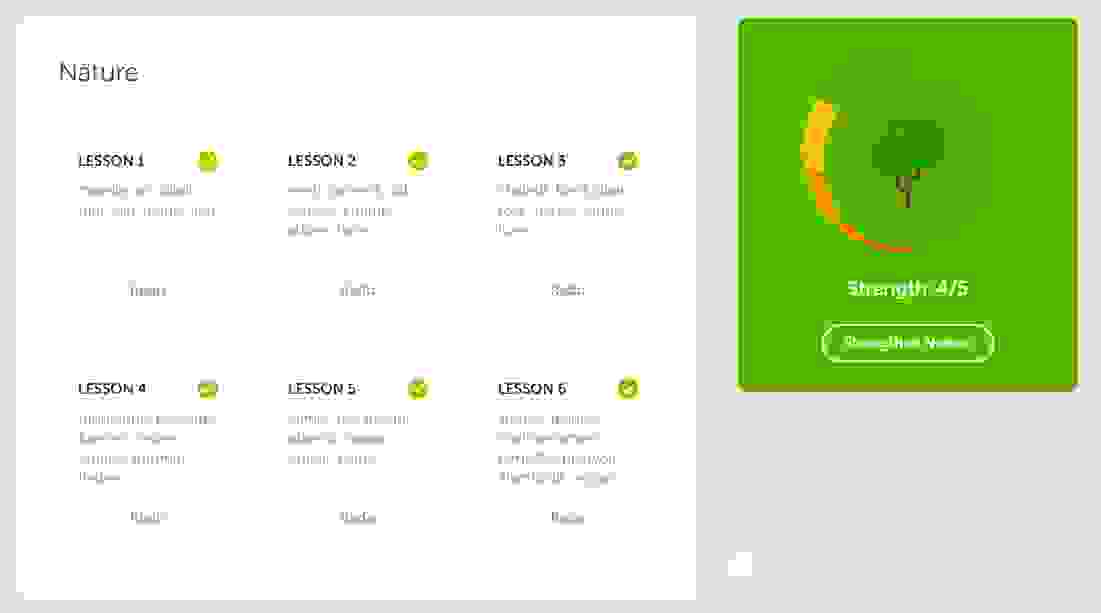
Each of those lessons includes 20 actual exercises (of one sentence each), so you can get a sense of the scale. It covers a lot.
So if you get all the way through it, you’ll be able to communicate. If you practice repeatedly until you rarely make major mistakes, you’ll be able to converse with native speakers without much trouble, except in the cases of weird slang terms or heavy accents.
So the scope of the lessons is great. Onto the details:
Things Duolingo does well
Each lesson within Duolingo includes several types of exercises, including reading, writing, speaking, and listening, in both directions (both English to French, and French to English, or whatever other language you’re learning). This is great. It covers a wide range of contexts, in which you absorb or produce sentences in whichever foreign language you’re learning.
Here’s one of the very first exercises, going from French to English:
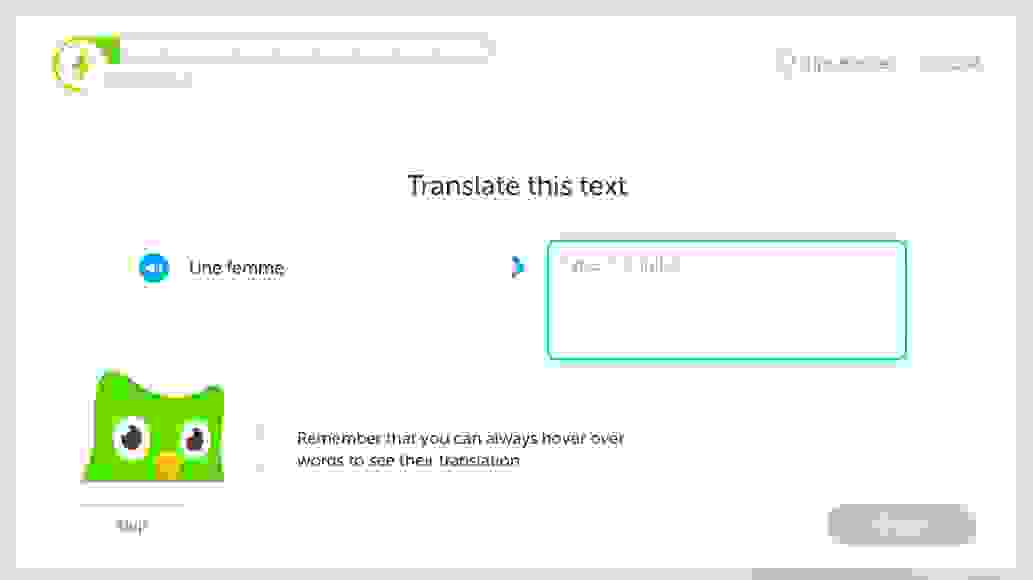
Lessons usually start with French words, so you can hover over the word to see its meaning. After running through a few of those, they’ll give you the reverse:
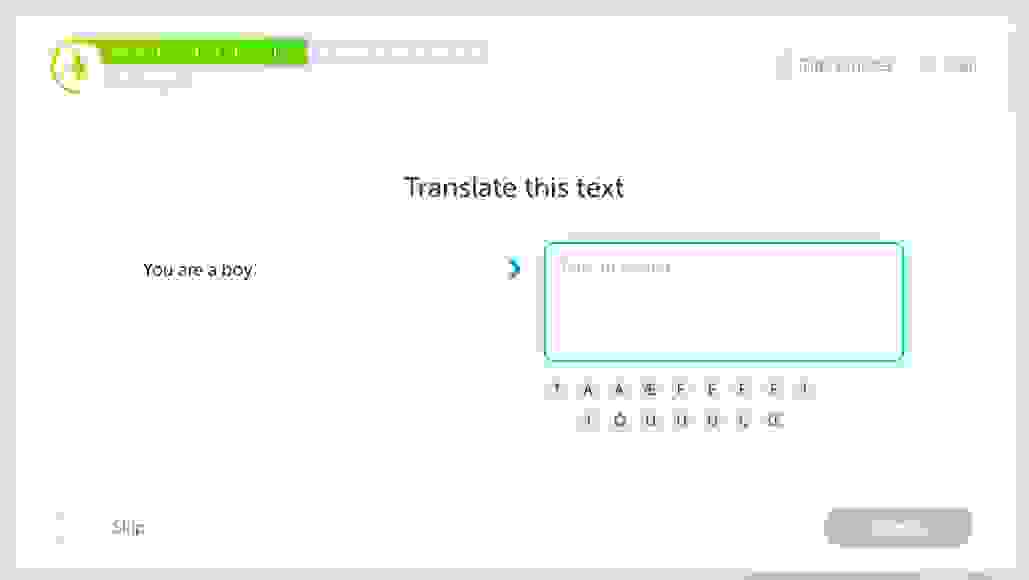
Every time you get an answer correct, that green progress bar moves forward a step; get an answer wrong, and it goes back a step. This is actually a very recent modification; it used to have Legend of Zelda style hearts, and if you lose all three of your hearts, you had to start the whole lesson all over again. The new system is a huge improvement, because you literally cannot fail, which makes it far less frustrating. You just keep trying, and you’ll get there. It seems to have doubled the rate at which I progress through these lessons. The smartphone app still has the heart system, but I expect they’ll change it soon.
They have several other types of exercises, including multiple choice, listening to a French phrase and typing what you hear, or listening to and repeating a French phrase into the microphone (although my microphone doesn’t seem to work very well, so I just switched off that feature).
The smartphone/tablet app also has a Mad Lib style exercise, where you select words already displayed on the screen, rather than typing them out. This cuts down on annoying smartphone typing (although it still has some), which makes the app a lot more usable than I was expecting:
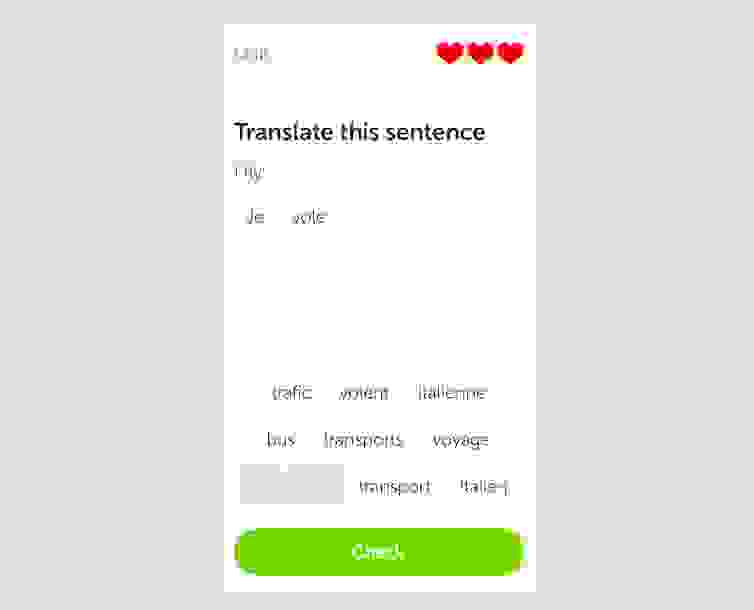
The app also synchronizes with your desktop/laptop account, so you can work on it at home, and picked up where you left off while you’re out.
The fact that it’s a program also means you can hear the correct pronunciations of every word, which, in the case of French, would be completely impossible with just a textbook.
And since it can tell you when you’ve made a mistake, you can see the correct answer immediately, so you won’t pick up bad habits and cement them for years before someone corrects you. It sometimes identifies your mistake specifically, especially if it’s just a word or two. It can’t do this all the time (particularly if your answer is just totally off), but I like that it’s sometimes able to give specifics, instead of just marking it wrong:

It also has a number of game-like elements, including leveling up, XP, bonus levels, rewards, and competitive rankings so that you can compare your progress with a friend’s (which allegedly increases your likelihood to use the program by quite a bit). I haven’t made much use of these, but I’ve heard from younger kids that they find it all quite enjoyable. It’s designed to be fun for everyone, but you can easily just ignore those elements if you don’t care. They don’t get in the way.
So if you’re wondering if it’s possible to learn a whole language just from a simple app, I would say the answer is an emphatic yes. Duolingo runs through every type of exercise you can imagine, covers a broad range of vocabulary and grammar, and offers advantages that textbook studies are incapable of providing, while simulating some of the feedback you’d get in a classroom setting, where a teacher could correct any potential errors. It’s really great.
I do, however, have some issues:
Things Duolingo does poorly
I’ve noticed the program has gone through some major design changes over the last few years, so it’s possible that some of these issues will be resolved at some point (and I’ll try to update this review if I see that happen), but, as it stands currently, here’s where you’re likely to run into trouble:
Major problem #1: No “survival” phrases at the beginning
The first few lessons in Duolingo consist of extremely simple words or phrases, so you build vocabulary gradually, one word at a time. This is great. But the specific words and phrases it teaches you in the beginning are not beginner phrases. Instead of teaching you “hello, how are you, what’s your name, where’s the toilet, how much does it cost,” and so on, it teaches you things like “he is a man, she is a woman, the apple is red, the cat is black.”
Obviously those are words you’ll want to know at some point, but it seems somewhat odd that it doesn’t stack the most-used introductory phrases up front. I was about halfway through the lessons before it covered how to ask for the toilet, and, as far as I can recall, “what’s your name,” and “my name is” were buried exclusively in the un-lockable bonus skill section titled “Flirting,” rather than being integrated into the regular lessons.
For this reason, I would say that if you’re in a huge rush to learn basic “survival” phrases really quickly in a short period of time, I would actually recommend not using Duolingo. If for some reason you have only a week or two to prepare, get a phrasebook or a cheat sheet of simple phrases and memorize them instead.
If, however, you have several weeks or months, Duolingo is a much better option. And I can kinda see why they did it this way, as the early lessons present just a couple words at a time, instead of lengthy, tricky sentences. Besides, it will eventually teach you everything you need to know; I just think it would have been somewhat more practical to place a few basic introductory phrases up front, before anything else.
Major problem #2: Very little grammatical instruction
Duolingo’s model works by throwing you right into the exercises, so you get started reading, writing, listening, and speaking right away, and the fact that it builds on existing knowledge by adding just one or two words at a time, letting you hover over a new word so you can see what it means, all add up to a system that works extremely well.
It does not, however, include comprehensive explanations of grammar rules. If you studied a foreign language back in high school, you might remember terms like subjunctive, preterite, imperfect, conditional, pluperfect, and their billion iterations when it comes to verb conjugation. Duolingo covers them, but they’ll do it with exercises, without telling you what’s going on and why.
On the one hand, I can see why they might do this; the program is trying to emulate natural language learning, by throwing you right into the middle of an immersive language experience, instead of spending time explaining when to use the preterite instead of the imperfect. That’s how kids learn.
But the people studying with Duolingo aren’t little kids. They’re most likely adults or teenagers, or maybe older kids (since you need to know how to read and type in order to use the program), all of whose brains are completely different from a toddler’s. Tiny children have an extraordinary ability to soak up language at a young age, but they’re terrible at grasping complex, abstract concepts, like what a participle is. Adults, on the other hand, are terrible at picking up foreign languages, but have a much easier time understanding those abstract concepts.
So I can understand why they may have wanted to do away with complex grammar lessons, and rely instead on simple repetition for a more “natural” approach, but it would have really helped if they had said things like “Alright, guys. This is the subjunctive. You use it when you’re talking about something that isn’t real. Like what you want to happen, or what would be sad if it were to happen. Got it? Alright, let’s get started.”
Instead, they just throw you right in, and by the time you’ve “mastered” the subjunctive lessons, you still might have no clue how to use it. If I hadn’t known it already from Spanish (since a lot of the grammar is the same), I think it would have been far more difficult.
This is, however, rather easily solvable; whenever you get to a new grammar rule that you don’t understand, Google it instead of relying on Duolingo to explain it to you, because it won’t. There are plenty of sites out there, as well as instructional YouTube videos, that will help fill the gaps. Once you get it, dive back in to Duolingo’s lessons and practice using whatever you’ve learned, and you’ll be just fine.
There’s also a little button that says “discussion” that appears at the bottom after you get questions wrong, where you can see user-submitted comments explaining the correct answer, and I would highly recommend making use of this as often as is necessary…but you can only see those comments after you submit your answer, and you also have to hope that some gracious Duolingo user has offered a useful explanation, instead of Duolingo just offering more thorough instructions at the beginning of each lesson. You’ll get some instructions, but I don’t find them sufficient for some of the more complex grammatical concepts.
It’s possible that you could learn all this merely by repetition, but I expect that looking things up and understanding them is likely to make things go a whole lot more smoothly than getting marked down for using por instead of para and having no idea why. It gets incredibly frustrating, and Duolingo mostly won’t help, other than just telling you that you’re wrong. So if you find yourself running into grammatical difficulties like these, just look them up elsewhere.
Major problem #3: Lack of repetitive drills
If you’re planning on using Duolingo to learn a Latin-based Romance language, such as Spanish or French, the worst part of all this is going to be verb conjugation. In English, it looks like this:
I go. He goes.
It’s the same verb, but it changes based on who’s doing it, as well as whether it’s in the past, present, or future (plus other factors), including variations like he went, he will go, he is going, he would have gone, and so on.
In Romance languages, it’s a billion times more complicated, and it’s really annoying.
Take a look at how many variations there are, just for a single verb, in past, present, and future:
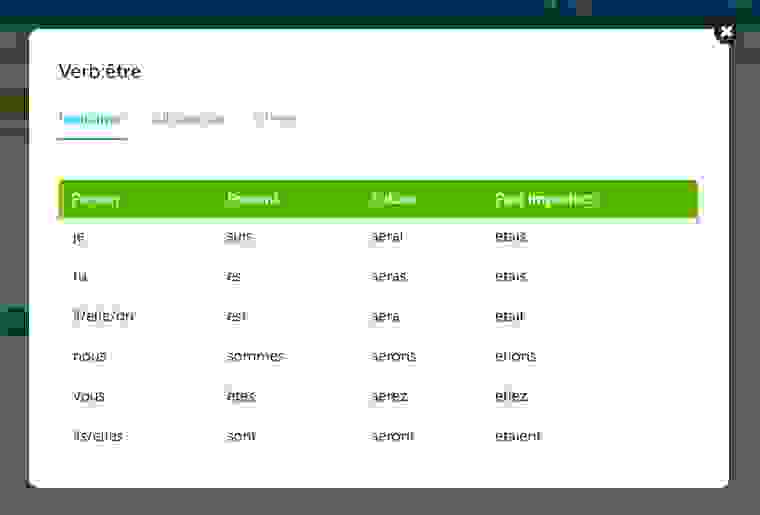
And that’s not all:
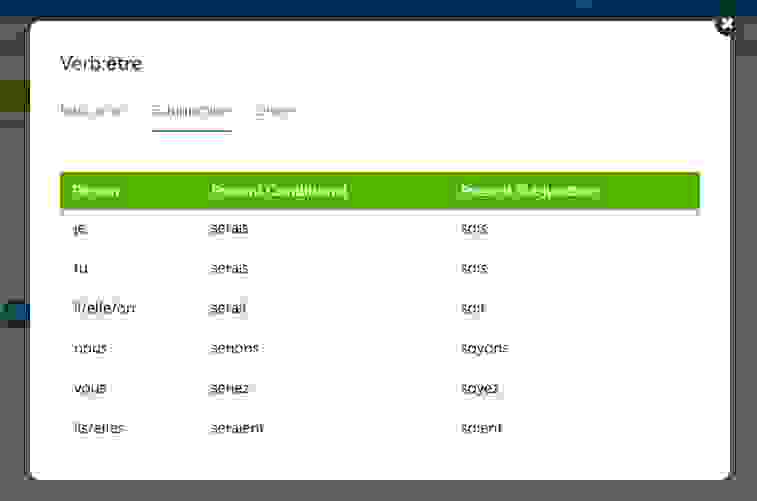
That’s still not all:
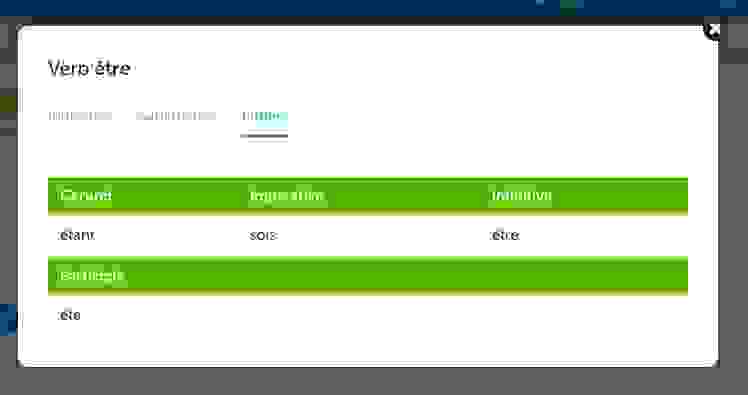
That’s a total of 34 variations, just for one verb. Imagine how difficult it is to have a conversation when you’re trying to remember which of these 34 verb conjugations is correct, and then saying the wrong one and ending up with a ridiculous miscommunication fiasco. You need to remember these quickly, or you’ll stumble all over the place.
Duolingo’s method of dealing with this is to insert these words into the standard exercises, so it’ll have sentences like he goes to the store before 9:00 on Saturday morning, and you’ll translate it, whether from French to English, or vice versa.
But that sentence had 10 words in it, and only 1 of them (goes) was the verb you needed to practice. So instead of bombarding you with highly-focused, rapid-fire verb conjugations drills, it’ll give you full sentences, which, in the case of the sentence above, would be 90% useless. It takes up lots of time, but only 10% of it was spent learning the new verb form.
Obviously it’s great to practice all sorts of words all the time, but I think in the case of verb conjugation, when you need to memorize 34 extremely similar but different verb forms and know which one to use, with perhaps a delay of 2 or 3 seconds so you’re not just standing there silently, you really need to drill them in, and I think this is where shorter, faster repetition would have been helpful.
If they just fired off phrases for you to translate like “I go, he goes, she goes, we go, they go,” and then repeated that cycle a few times, then switched to the opposite language, and repeated that cycle a few times as well, it would drill those words in a lot faster, and then it could progress to the typical, full-sentence exercises. I found myself just writing these out on paper to solidify verb conjugation exclusively, because I find the drilling to be helpful in situations like these.
Earlier lessons do this better, by the way. Those beginner exercises use much shorter sentences, consisting of maybe 2 to 5 words, which makes iteration super speedy. So they wouldn’t necessarily need to shorten the exercises down to just the verb, but shorter and faster is better.
If you’re not learning one of these Romance languages, you might not run into this specific problem at all; but I expect most other languages have their own annoying aspects, and it might not be a bad idea to devise your own repetitive drills if you run into similar problems. Another good example would be any time you have to learn a whole bunch of new words all at once. Numbers, days of the week, months of the year, seasons, and so on. It’s helpful to drill these quickly.
Again, this is a potential problem. If you just practice the existing lessons a couple more times, you’ll get that extra practice anyway. But I think speeding up the iteration time by using shorter sentences would be helpful.
Other minor nuisances
Tiny accent mark letters. Some of these languages require extra letters that aren’t present on whichever keyboard you may have (such as é and ñ), and Duolingo gives you clickable buttons on the screen so you can use those letters without having to learn new keyboard commands. But those accent marks are incredibly tiny.
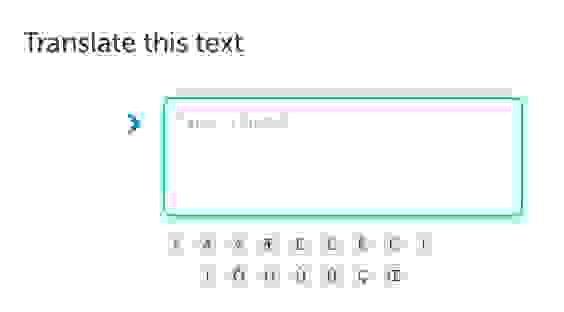
There are four different “e” options and I literally have no idea which is which. There’s maybe one pixel of difference, and it’s such a nuisance that I just don’t bother with the accents at all. They really need to make those letters bigger.
Can’t see masculine or feminine indication sometimes. One of the most annoying things about Romance languages is that nouns have gender, even if they’re inanimate objects, so you have to remember that something is called he or she instead of just it, which also affects the adjectives used to describe those nouns, because they have to match. When you hover over an English word to get its translation, it’ll show you the word, but it won’t tell you the gender, meaning you have a 50% chance of getting the entire question wrong, sometimes because of just a single letter. If they’re going to let you peek at the definition of the word so you can get a hint, they should let you see the gender as well.
Can’t see conjugation sometimes. I say “sometimes,” because for some reason, when you’re going from French to English, you can hover over a verb to see its definition, and there’ll also be a button that says conjugate:
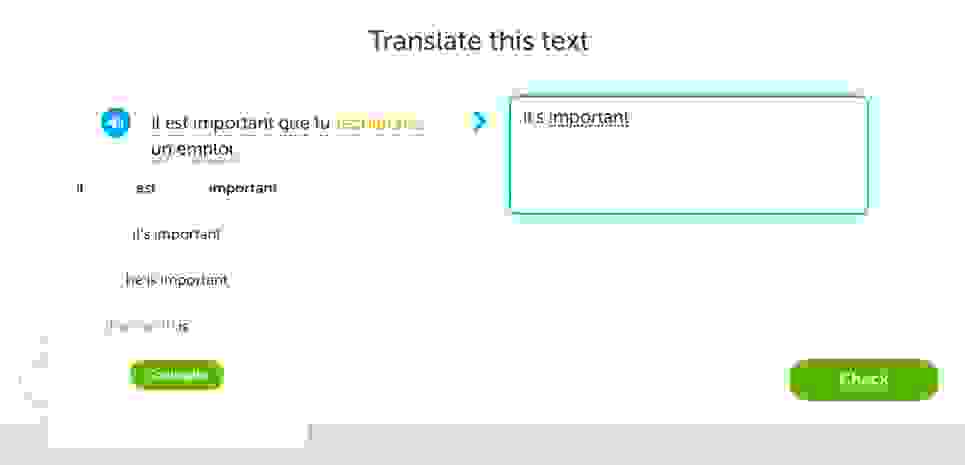
That button brings up that big verb conjugation chart showed up above, back where I was complaining about verb conjugation.
But when you’re going from English to French, you’re out of luck:
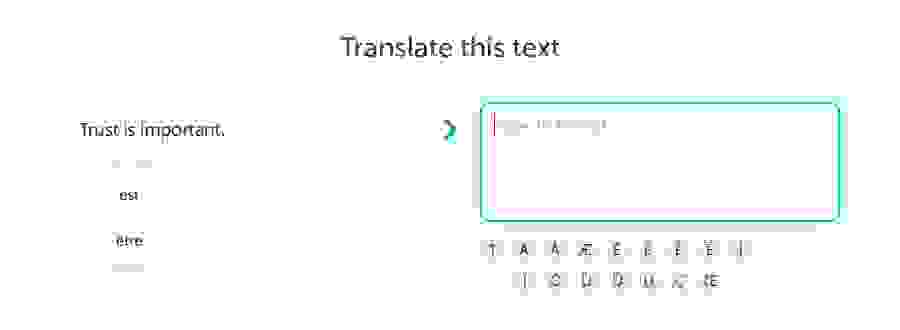
This is actually the time you need it the most, because you have to know how to spell it, too. I think it’s because sometimes there might be multiple verbs that would qualify as correct translations, so they can’t have just a single conjugate button at the bottom. But they could have a conjugate button for each verb, just to the right.
Sometimes those hover-hints aren’t correct, either. The hint gives a word-for-word translation, without taking into context the surrounding words, so it’s not always right. But, of course, it’s just supposed to be a hint, so you shouldn’t rely on it all the time.
Some answers should be accepted. Some questions have multiple correct translations, but Duolingo doesn’t know it. There’s a button if you get a question wrong that says “report a problem,” and within that, an option that says “my answer should be accepted.” This is just something that will improve with time, but it gets kind of annoying when you provide an answer that’s clearly right, and it doesn’t like it.
There should be a silent mode. You can shut off the speaking exercises so you don’t have to talk out loud, and use headphones so you’re not disturbing anyone, but I think there should be a total-silence option, at least for the smartphone app, for those times when you don’t want to put on headphones. This could just be operated by the phone’s silencer switch, or whatever it’s called. When you switch your phone to silent, the app would go silent. When you switch your phone out of silent, the app would talk again. A little pop-up in the corner could notify you when you first open the app to let you know which mode you’re in.
It’s mostly just translations. I’ve heard from some people who’ve used other language learning methods that those techniques force you to think in those other languages, rather than just translating, which requires you to go back and forth between multiple languages. Translating is important, but maybe they could add some fill-in-the-blank exercises as well.
Conclusions!
Though it may not be entirely obvious given the amount of complaining I’ve done here, I love the existence of Duolingo, and highly recommend it to everyone I meet who has any interest in learning languages.
The fact that I could go from absolutely zero knowledge of French to halfway-competent with no other instruction whatsoever, entirely for free, is absolutely spectacular. Though I was rather shaky when I first spoke with other French speakers, it was obvious from those conversations that it was just a matter of running through the existing lessons to get more practice, especially as I had sped through the latter half. You can really learn a whole language with this, and quite well.
I would say Duolingo does (at the moment) have a few shortcomings, the most significant of which are its lack of basic “survival” phrases upfront, a lack of sufficient explanations for complex grammatical concepts, and a lack of repetitive drills; I would recommend resolving these issues by Googling important survival phrases if necessary, Googling explanations of complex grammatical concepts whenever you need more detail, and conducting those repetitive drills on your own. I think I’d like to see Duolingo add these at some point, but in the meantime, it’s easy enough to supplement it with other content for free, to fill in the gaps. So by all means, use it. Just know how to handle those potential issues, and you’ll be fine.
Well, I would say it’s off to the next language, but I really need to solidify my beginner French before moving onto the next one. I’d also like to work on my Russian, which is still rather appalling (and Duolingo says they’ll add that later this year), but in the meantime, there’s another site called Babbel which has Russian lessons, and I think I’ll give that a try and see how it compares, and add some thoughts here (Update: Here’s my Babbel review!).
So, go learn something new!




Hi Snarkynomad,
Thanks for review. I was confused to use duolingo or not, but now i will give a try. I have learnt basic french from Alliance Française. French will be my fourth language :)
Stay Nomad, stay happy !!!
Good luck with learning. It takes some time, but it’s worth it.
I have been using duolingo but I got stuck half way through as I was asked questions which had not been covered in previous lessons so I had to abandon it haf through.
I finished all of Italian. And I can tell you I dislike it. Because it didn’t give me enough vocabulary. Moreover, no clear explanation about using of articles and prepositions.
There are other programs that go further with vocabulary, but they tend to be pretty expensive. Duolingo is the equivalent of the first year or two of college-level lessons, after which you’re on your own, or you have to find another service. But I think it’s great that it goes that far for free.
I disagree that it is any level. Because I have no understanding of the grammar and can’t understand any even easy phrase. I am sure there are better applications for study languages for free. If I find I will tell you.
I don’t think it is the right programme if you are learning from scratch. It assumes you have avcertain level of French. I am stuck in the middle as it won’t let me proceed and I now have to learn the answers before I can. Which is not a bad thing itself but not very encouraging to me to finish the programme.
Personally, I actually really like that the first phrases are more like “he is a man” – because it teaches you subconsciously all the i, you, he/she/it etc. in addition to verb conjugation but instead of just memorizing all the verb tenses it simply slides into your memory with time; and one day you know that “je suis” sounds right but “tu suis” doesn’t.
I also like that it doesn’t focus on grammar because trying to understand and remember all the grammar rules often ruins your progress as people tend to think a language is too much to handle when they see how much grammar it comes with. Truth be told, you will NEVER know all the grammar, not even in your native language. Learning a new language should be approached more like a skill you’re gaining rather than a formula to memorize and follow, at least in my experience.
Of course, wanting to understand the grammar rules that lay behind the structures of a language is natural, but it should be something you come back to after having a good enough grasp of the language already.
That’s how I learned all three foreign languages I speak. No grammar, just exercises like those on duolingo + movies, books, music, as much as possible, also speaking the language out loud to yourself as much as you can.
I agree that grammar can get incredibly annoying, and the grammar lessons they’ve added are sometimes hard to deal with, because of all the terminology we don’t now much about. I think verb conjugation would be great, though, in a little more of a repetitive drill style, at least for a few cycles before moving onto full sentences.
Thanks for the review, I literally began Norwegian about 24 hours ago and have been addicted to it since. I’m already up to level 6. But I was still curious about whether it’d work, so your review has been very useful. I’m tackling the survival phrases issue through channels like Norwegian Pod 101 on YouTube (The company that makes that channel is very good, they have SO many other channels for different languages it’s crazy. Just to name a few they have Spanish Pod 101, Italian Pod 101 and French Pod 101) which has a playlist of videos with basic phrases.
I think the grammar part has not been emphasized enough. Yes, you can make up for the lack of grammar instructions by googling everything you cannot find in Duolingo, but it is NOT efficient at all. I am not a kid and I do not have ~10hrs (or more) a day, 365 days a year, several years to learn a new language. I care about learning a language with my time spent wisely. Even a good traditional language instructional book with solutions and notes does a good job in making you aware of all the language points you need to know.
And I forgot to mention that Duolingo does not seem to do a good job in pronunciations. It does not help you really practice all the sounds, which can be very important to future language learning, especially memorizing words. They obey rules and there are often exceptions, which is in no way trivial and requires learning and practicing. I personally do not think it a good idea to just mess around with the pronunciation at the beginning.
Thanks for review. I use duolingo for learning basic english.
I am pretty happy because I read your text and I understood it !
I laughed a lot because Iam french, and your description of my native language is so true, especially when you talk about conjugations….
Merci pour ce fou rire !
Duolingo is working for me and this review was helpful. Unlike Snarky Nomad, my occasional ventures into language learning have been pretty disastrous. I got a “D” in my O’Grade at school (GCSE equivalent) and have made little progress since. Although I have tried a couple of times, off and on, to learn both French and Italian, I can’t even make basic requests in either language.
I have been working through Duolingo for a couple of months now. I do not intend to devote more than 5 or 10 minutes a day, but I also don’t plan to finish it for about two years. It is encouraging to me that I will have a basic grasp of the French langauge after that. None of the objections raised in your piece are a problem for me. I really only want to get to the stage where i can sit down and read Le Monde or a Simenon novel with a reasonable grasp of what is written. From what you write about the programme, that seems to be a realistic goal, as long as I keep a good French-English dictionary to hand!
As someone who feels like acquiring a second language is like overcoming a disability, it is very encouraging to think I can, in the comfort of my own home, be able to, one day, understand another language, however imperfectly.
Thanks for the review— it has helped me press on.
No problem. Always happy to help someone with something important to them. It takes a while and you have to keep up with it, but that’s really all there is to it.
Hello. If You decided to learn french you can visit https://preply.com/en/french-by-skype to find tutors and teachers. It will be easy french learning for you.
Me too I’ve been using Duolingo for French studies however not as a beginner but as skilled so I’m not familiar with the basic lessons. Probably it’s due to my prior French knowledge that one of my concerns with Duolingo is the audio; the male voice is OK because it’s human and he articulates entire sentences however the female voice is quite terrible and in fact sometimes it’s teaching you the wrong pronunciation so be careful with it.
The problem is that they are using some robot for the female voice but sometimes it doesn’t use the correct sounds because in French the pronunciation is not something static, it can vary depending on the surrounding sounds and the robot is not always good in guessing the right one. Maybe it’s just me but on one hand I find it overall annoying because it’s not always audible properly and on the other hand it’s a bit counterproductive if you try to learn French pronunciation (which is not easy).
Overall it’s a useful tool, I’m still practicing with it but I think I prefer Memrise at the moment. Or maybe the best is using them together…
Hmm, good to know. The way the female voice says “singe” (monkey) is totally weird.
“Singe” pronounciation: Where? In which lesson?
Every time. She sounds like she’s hiccuping when she says it, or something like that.
Problem is mainly the liaisons, except that, the audios are not so wrong, and when it’s wrong, often some natives report it in the forum, and try to provide a forvo link.